You can dramatically reduce your fall risk by up to 50% through consistent aquatic exercise training. Water’s buoyancy supports your joints while providing 15 times more resistance than air, making it perfect for rebuilding strength and balance safely. Start with basic water walking techniques, maintaining tall posture and engaging your core in waist-deep water. Progress to advanced stability drills like floating mat exercises and multi-directional movements that enhance coordination and boost your confidence in everyday activities.
Understanding Fall Risks for Older Adults

Why do falls become such a significant concern as we age? If you’re over 65, you’re facing a one-third chance of experiencing a fall each year. Your fall risk escalates dramatically with age—if you’re 80 or older, that probability jumps to over 50% annually.
Several factors contribute to your increased vulnerability: muscular imbalance, weakness, poor posture, and sedentary habits that worsen over time. These physical changes directly impact your balance and fall prevention capabilities.
The consequences aren’t minor—seniors 75 and older face 4-5 times higher odds of long-term care admission.
Perhaps most concerning is the fear of falling that develops after an initial incident. This fear often reduces your physical activity levels, creating a dangerous cycle that further deteriorates your fitness and increases future fall risks.
Why Water Provides the Perfect Exercise Environment
When you exercise in water, you’ll immediately notice how your body feels lighter and more supported thanks to natural buoyancy that reduces stress on your joints.
You’ll also experience water’s unique three-dimensional resistance that’s up to 15 times greater than air, providing gentle yet effective strengthening for your muscles.
This combination creates an ideal environment where you can build strength and stability without the harsh impact of land-based exercises.
Natural Buoyancy Support
Water acts as nature’s safety net, cradling your body in a supportive embrace that transforms challenging exercises into manageable movements. The natural buoyancy reduces your body weight by up to 90%, dramatically decreasing falls risk while allowing you to perform exercise for balance with confidence.
This aquatic exercise environment offers unique advantages:
- Weight Reduction – Buoyancy supports your joints, eliminating painful pressure during movement.
- Stability Enhancement – Water’s resistance provides constant support, preventing sudden falls.
- Movement Freedom – You’ll move more confidently without fear of hitting hard surfaces.
- Pain Relief – Reduced gravitational stress allows comfortable exercise even with chronic conditions.
The buoyant properties create an ideal training ground where you can safely challenge your balance and strength.
Three-Dimensional Water Resistance
Unlike air-based exercises that only challenge you from limited directions, water’s three-dimensional resistance creates a complete training environment that strengthens your muscles from every angle. This unique resistance can be up to 15 times greater than air, forcing your body to work harder while maintaining stability.
As you move through water, every muscle group activates to counteract the resistance from all directions, improving balance and coordination simultaneously. The buoyancy reduces impact on your joints while you build strength, making movements safer and more controlled.
Water’s supportive nature allows you to practice balance exercises without fear, greatly reducing your risk of falling. You’ll develop better proprioception and muscle memory through slower, more deliberate movements that enhance overall stability.
Essential Water Walking Techniques
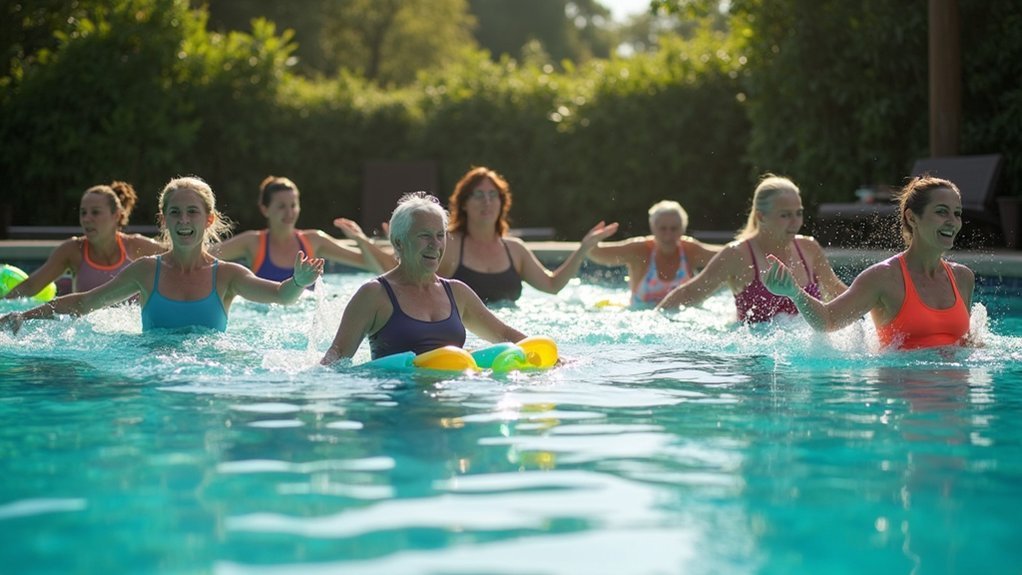
Since proper form determines the effectiveness of your fall prevention routine, you’ll want to focus on mastering fundamental water walking techniques that translate directly to improved land-based stability.
The buoyancy of water reduces impact while challenging your balance systems, making it ideal to prevent falls.
Master these essential water walking techniques:
- Maintain tall posture – Keep your chest up and shoulders back to enhance stability and balance throughout your workout.
- Engage your core – Pull your belly button into your spine to improve overall posture and reduce fall risk.
- Use natural arm movement – Keep arms slightly bent and move them in opposition to your legs, mimicking land-based walking patterns.
- Keep feet flat – Avoid walking on tiptoes; maintain full foot contact with the pool bottom for maximum control in waist- to chest-high water.
Basic Balance Exercises for Beginners
Building on your water walking foundation, you’ll now progress to targeted balance exercises that specifically address fall prevention. Start with high knee marches, lifting each knee while balancing on one leg for 3-5 seconds. This Water Exercises technique strengthens your core and improves stability.
Next, perform side lunges using the pool wall for support. Gradually reduce your grip as confidence builds. Practice one-leg stands with wall assistance, focusing on maintaining proper posture. These movements are essential balance training components for older adults.
Side lunges with wall support build confidence and balance while gradually developing independence in movement control for safer daily activities.
Add arm raises and pushups in shoulder-deep water to strengthen your upper body while challenging stability. The water’s resistance enhances muscle engagement without joint stress.
Regular practice of these exercises will greatly reduce the risk of falls while building confidence in your movement abilities.
Advanced Aquatic Stability Training
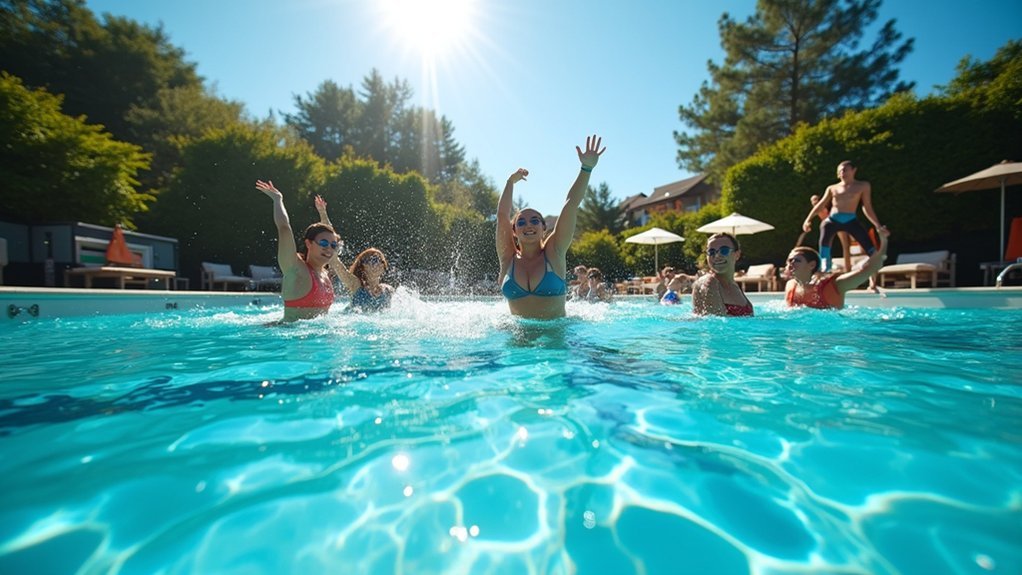
Once you’ve mastered basic balance movements, advanced aquatic stability training challenges your body through dynamic, multi-directional exercises that mimic real-world fall scenarios.
These sophisticated techniques utilize water’s unique properties to strengthen your core and improve gluteus medius function, essential muscles that balance and reduce fall risk.
Physical therapists recommend these progressions:
- Aquabike training – Pedal against water resistance while maintaining upright posture
- Floating mat exercises – Perform squats and lunges on unstable surfaces
- Perturbation drills – Practice recovering from unexpected pushes and pulls
- Multi-directional walking – Navigate forward, backward, and sideways movements
This thorough approach can decrease your fall risk by 50%.
Commit to six months of consistent training to achieve significant improvements in functional mobility and prevent falls effectively.
Building Core Strength in Water
While water’s buoyancy protects your joints from impact, its natural resistance transforms every core movement into a powerful strengthening exercise. Water provides up to 15 times greater resistance than air, making aquatic planks and high knee marches incredibly effective for targeting your core muscles.
The three-dimensional resistance you encounter during water-based exercises to improve balance works your stabilizing muscles from multiple angles simultaneously. This thorough engagement strengthens your entire core system, improving posture and body control essential for preventing falls.
As you perform these aquatic movements regularly, you’ll notice enhanced stability and confidence in your daily activities. The supportive water environment allows you to challenge your core safely while building the strength necessary to reduce fall risk and maintain independence.
Improving Coordination Through Pool Movements
As you move through water’s natural resistance, your body must constantly adjust and recalibrate to maintain control, creating an ideal environment for developing coordination skills.
Water’s buoyancy reduces fall anxiety while its resistance—up to 15 times greater than air—forces multiple muscle groups to work together harmoniously.
Pool movements enhance coordination through several mechanisms:
- Three-dimensional resistance challenges your body to stabilize movements in all directions
- Slower motion allows time to detect and correct postural errors during exercises
- Reduced fear of falling lets you focus entirely on coordination improvement rather than stability concerns
- Progressive muscle engagement strengthens balance reactions through consistent aquatic practice
Regular water walking and sideways stepping exercises will greatly improve your coordination and balance over time, making you more confident in daily activities.
Safety Considerations for Aquatic Workouts
Before you step into the pool, you’ll need to address several critical safety factors that can make or break your aquatic workout experience.
Water temperature should feel comfortably warm but not hot, typically between 83-88°F, as overly cool water can cause muscle stiffness while excessive heat may lead to fatigue or dizziness.
You must also secure proper medical clearance from your healthcare provider and master safe entry and exit techniques using handrails and taking your time on wet surfaces.
Water Temperature Guidelines
When you’re preparing for aquatic exercises, water temperature plays an important role in both your safety and workout effectiveness. Following proper water temperature guidelines guarantees your aquatic exercise sessions remain safe and effective while supporting your fall prevention goals.
The ideal temperature range for your pool workouts should be:
- Ideal Range: 83°F to 88°F (28°C to 31°C) for maximum comfort and safety
- Avoid Cool Water: Below 83°F can cause muscle stiffness and increase injury risk
- Prevent Overheating: Above 88°F may lead to dehydration and heat-related issues
- Monitor Personal Response: Assess your individual tolerance and adjust accordingly
Remember that hydration remains vital during water-based workouts, even when you don’t feel yourself sweating.
Drink water before and after your sessions to maintain proper hydration levels.
Entry and Exit Safety
Pool entry and exit represent the most vulnerable moments during your aquatic workout routine. You’ll prevent falls by wearing slip-resistant footwear and checking for hazards before approaching the water.
Always grip handrails or pool edges when navigating in and out of the pool to maintain stability. Enter slowly with deliberate, small steps rather than rushing into the water. Quick movements disrupt your balance and increase fall risk.
When you exit, verify that ladders and steps are properly positioned and dry. Wet surfaces create dangerous slipping conditions.
Consider installing poolside mats or soft tread flooring around entry points. These materials provide extra traction during changes.
Medical Clearance Requirements
Although aquatic exercise offers exceptional benefits for fall prevention, you’ll need medical clearance from your healthcare provider before diving into any water-based fitness program. This safety step guarantees your workout plan matches your individual health profile and minimizes risk.
Your medical clearance should address several key areas:
- Chronic conditions assessment – Cardiovascular issues, arthritis, or diabetes require specialized exercise modifications.
- Recent surgery or injury evaluation – Past falls or operations may impact your aquatic exercise capabilities.
- Medication review – Certain drugs affect balance and coordination, increasing fall risk during water workouts.
- Mobility limitations analysis – Physical restrictions help determine appropriate exercise intensity and duration.
Healthcare providers can design tailored programs that prioritize safety while maximizing fall prevention benefits through structured aquatic exercise.
Creating Your Personal Water Exercise Routine
Since water provides natural buoyancy that reduces joint stress while offering resistance training benefits, you’ll find creating a personalized aquatic exercise routine becomes an ideal foundation for fall prevention.
Start your exercise program with basic water walking techniques—forward, sideways, and backward movements that enhance balance and coordination in this supportive environment.
Utilize water’s natural resistance, which is 15 times greater than air, to strengthen muscles through high knee marches and lunges. These movements directly reduce your fall risk while building stability.
Incorporate core-strengthening exercises like pool planks and one-leg stands, using pool noodles for support. Hold positions for 15-30 seconds initially.
Gradually increase challenges by adding swim spa currents or varying speeds. Schedule workouts twice weekly for six months to see significant improvements in mobility and physical therapy outcomes.
Frequently Asked Questions
What Are the Best Exercises to Prevent Falls?
You’ll prevent falls by strengthening your core, practicing balance exercises, walking regularly, doing leg strengthens like squats, improving flexibility through stretching, and maintaining good posture. Don’t forget proper footwear and home safety modifications.
What Is the Best Water Exercise for Seniors?
Water walking’s your best choice for aquatic exercise. You’ll get land-walking benefits with water’s supportive buoyancy, reducing fall risk while strengthening muscles through natural resistance that’s fifteen times greater than air.
What Exercise Burns the Most Belly Fat in the Pool?
You’ll burn the most belly fat with high-intensity interval training in the pool. Combine water jogging sprints with core exercises like water planks and leg lifts to maximize calorie burn and target abdominal muscles effectively.
How to Decompress Your Spine in a Pool?
You’ll decompress your spine by standing in chest-deep water, allowing buoyancy to naturally elongate your back. Gently hang from pool ladders, use floating devices for support, and perform gentle spinal stretches while water reduces compression forces.
In Summary
You’ll find that consistent pool exercises transform your balance, strength, and confidence. Start slowly with basic water walking, then progress to advanced stability challenges as you’re ready. Remember to prioritize safety by exercising with supervision and following proper protocols. Don’t wait to begin – your fall prevention journey starts with that first step into the water. You’ve got the tools; now it’s time to make aquatic exercise your powerful ally against falls.

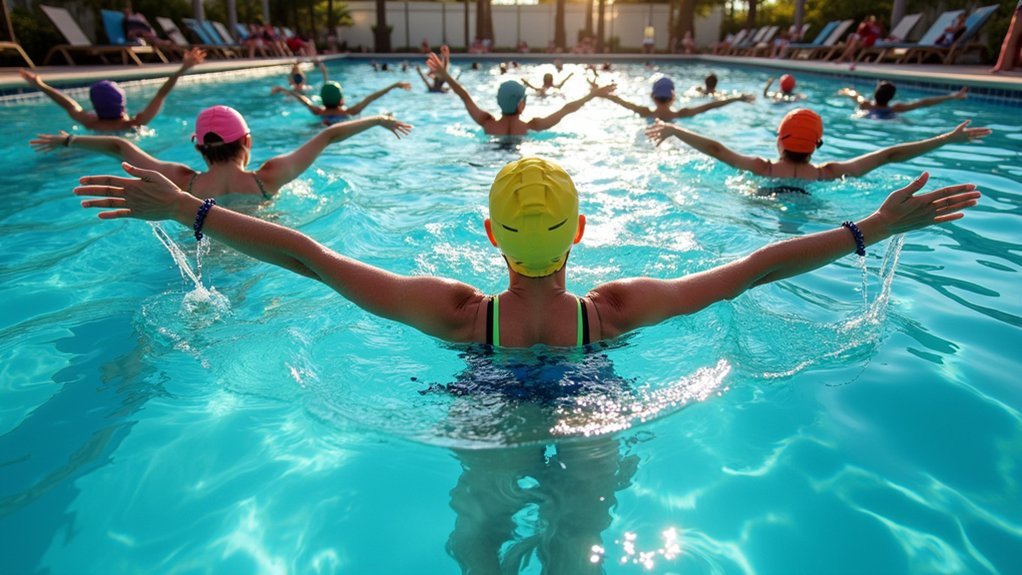
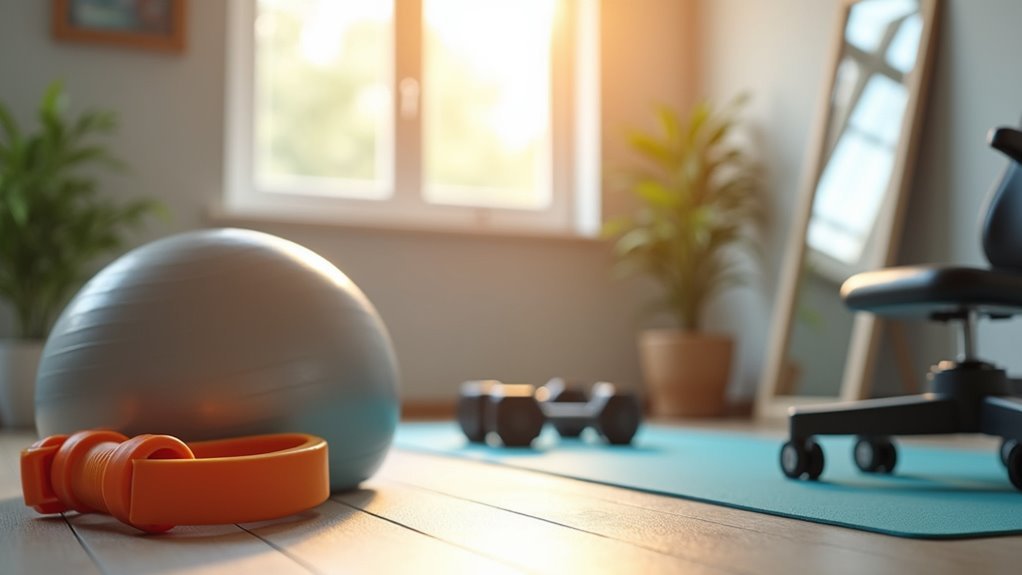
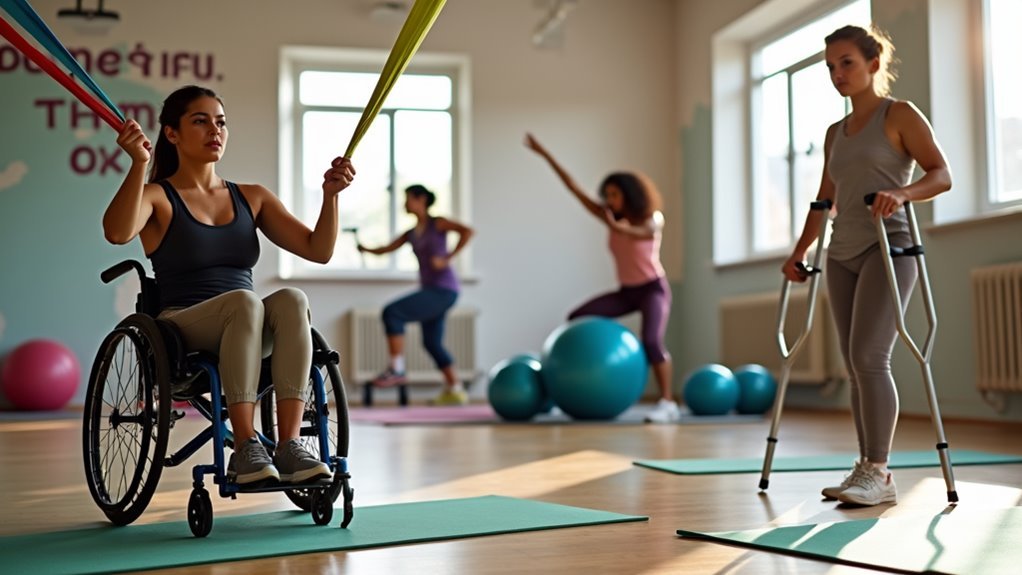
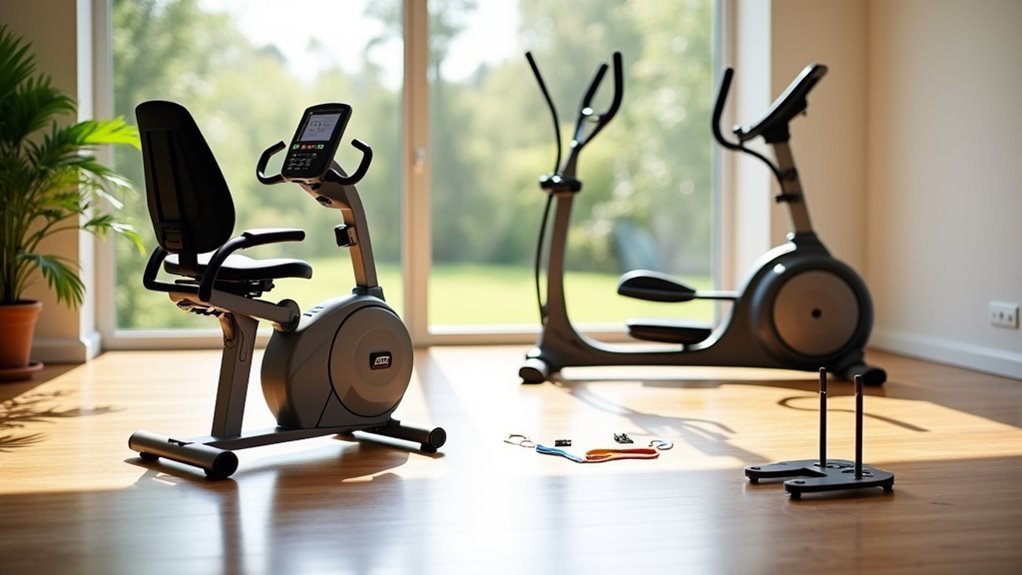
Leave a Reply